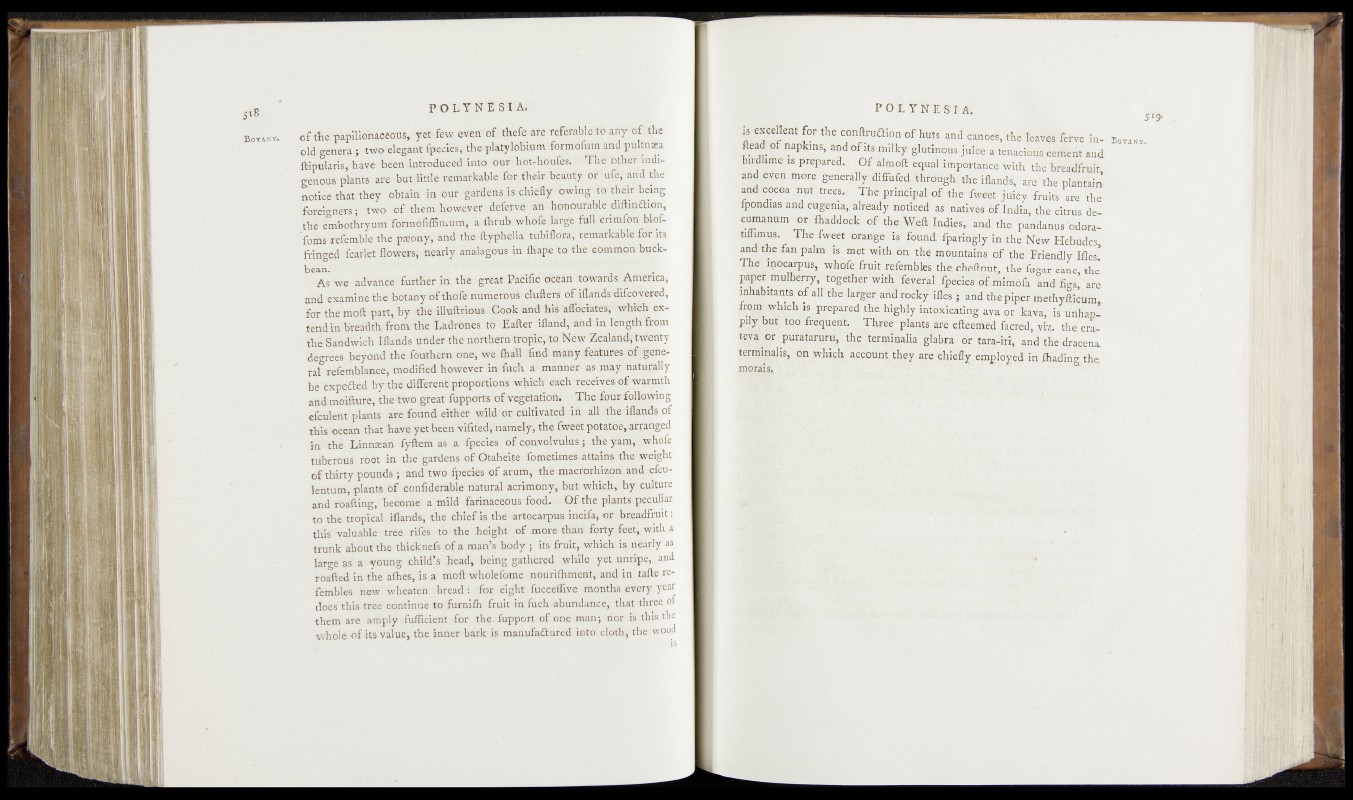
B otan?* of the papilionaceous, yet* few even of thefe are referable-tb'<any of the
old genera; two-elegant-fpecies, the-pktylobinm formofum and pultnaea
ftipularis, have been-introduced-into ourhOfhoufes.' The otheMhdi-
genous plants are but-little remarkable for their bekuty or^ufe, and-the
notice that they obtain dn our gardens is chiefly owing to theii^bêing
foreigners; two o f them however deferve an honourable difoh&iOn,
the embothryum formofiffimum, a flirub whofe largefulhcrimfo’n, bfof-
Toms refemble the pseony, and the ftyphelia tubiflora, remarkablefohits
fringed fcarlet flowers, nearly analagous in fhape to the commoh'buekbean.
.......... • -
As we advance further in the great Pacific o’cean towards America,
and examine the botany of thofè numerous clhftefs of iflands'd'ifsoVered,
for the moft part, by the illuftr-ious Cook and his'-a-ffociatesV'wM'ch exten
d in breadth from the Ladrones to Eafterdflarid;'-a-nd in le-ngth-from
the Sandwich Iflands under the northern tropic,-to'New Zealand^tWenty
degrees beyond- the fóöthewt-oae* wè'fiufll find many;foa;foresófefeneraTTefemblanee,
modified however in fuch a manneskatf inky n a ttily ,
be èxpedted bythe different proportions which each-receives of Warmth
and moifture, the two great fupports of vegetation: • Thelfoi^fl^Q^ing
efculent plants are found either wild or cultivated in. alkfhe*iflands <0
this ocean that have yet been vifited,namely,-the fweëtip©ta^i*y|anged
in the Linnsan fyftem as a fpecies of convolvulus^ the y a m f o f e
tiiberbus root in the gardens o f öïaheite fometimes attains -thippeight
of thirty pounds 9 and two fpecies of a rum ,/^m a c r« )^ ^ iri:a la i.|^ ri
lehtum, plants of confiderable natural acrimony, but which, byfegkure
and roafting, become a mild farinaceous food. Of the plants|p&uliar
to the tropical iflands, the chief is the artocarpus incifa, »r:.breadfruit:
this valuable tree rifes to the height- of more thart-forty feet,-Vth a
trunk about the thicknefs of a man’s body 5 its fruit, which- is nearly as
large as a young child’s head, being gathered while yet .unripe*;-and
roafted in the afhes,is a moft wholefome nourifhment, and in tafte re-
fembles new wheaten bread : for eight fucceffive months every , year
does this tree continue to furnifli fruit in fuch abundance, f h |t three of
them are amply fufficient for the fupporfof one man; nor is this the
whole -of its value, the. inner bark is manufactured into' cloth,- the wood
51'9>
1 c“ e! ent f ° r * • fantf-caribei, the jW f c r f a * » .
fte adw f napkms; j f f e ^ a A a i c e n i e n t and.
birdlime is prepared, B m M H g
and-.eren more g a t a # i J H b f t d ^ r ^ f c H M H j f l I R H h
andxocoa n ib trees. ’F J f e p r i d d i # M lw * d s ;> |* J ! y,,'fra iis a ii- f f iT
fpondias and eugema, already'hoficed as riat&& fef India, 4 &dbiyr de-
cumannm-or flteddobk
tilhmds. T h e fWeer orangejis*-foifntf fp # ih g r ffj^ t|io 'N ew H eb d d b i
and the fan palters-; met w ith 6 f t^ » -m 6 (u n ta 1 h ^ 4 ^ f e e ^ ^ i© n ^ r lfle8‘
The mocarpus, whpfo fruit refertlbles th e .c h e fW th e A g a r cane the
paper mulnerdy^togeflter with’
inhabitants of all- th e k ^ e r ' a f i d l b c f f W f and t h e ^ W S f e f f i c u m ,
the h ighly intoxicating S W i
pily^but too frequent. Three* pHnts ,are e f te e ^ d
teva_ qf pufatafuni, the^terminalia' g'rahri ^ o f 'f e i r iV l ^ d ■ M | | [
terminals, on which accpuntsthey are chiefly’employed in lhading th e
morais.
Botan y..